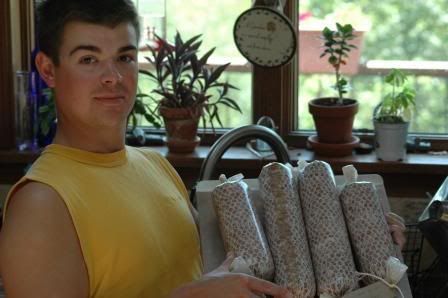Ross wrote:
I spent a little time closing seams and joints in my workmanship on the chamber. I am becoming convinced that this needs to be rather air tight and we must have control of the ventilation and not leave it to chance. If you have built your chamber and have difficultly with control I think that caulking the seams and joints would be a first step.
Ross, ol` buddy, I`ve been chuckling for a couple of hours.

Seems, you have learned something the hard way. Yes, it must be "rather air-tight", or at least "fairly" air tight. Enough so there`s not an "ingress" of
uncontrolled air. In a wooden cabinet chamber, this could be a challenge. Silicone caulking is a good idea.
Let`s look at what we are attempting to do with our "fermentation chambers". We are going to
purposely spoil meat... but it will be
controlled spoilage called fermentation. Many foods are prepared in such a manner. And what causes this "spoiling"? Bacteria. In meat, we use
lactobacillus and
pediococcus, feeding on sugar (carbohydrates) to produce lactic acid. This bacteria competes for nutrition with the undesirable spoilage bacteria (
brochotrix thermosphacta and
pseudomonas spp.) et. al., as well as pathogenic bacteria of several varieties. Of greatest concern are
staphylococcus aureus, clostridium botulinum, listeria monocytogenes, escherichia coli, salmonella, clostridium perfringens, campylobacter jejuni, shigella, and
bacillus cereus.
What makes these bacteria safe when consumed in meat, cheese, or any fermented food?
Acidity! Bacteria do not do well in an acidic environment. In meat,
lactobacilli produces acidity and when it increases, dropping to a point between 3.8 and 5.5 on the pH scale, it becomes safe to consume. The acidity of a sausage is determined by the amount and the type of sugar placed into the recipe. The
speed of the fermentation period is
increased as the temperature is increased inside the chamber. It ceases when no more lactic acid is produced. This happens when there is no more sugar available to the
lactobacilli. It will also stop when the temperature is lowered below 53°; F., or heated beyond 120°; F. Fermentation will also discontinue when there is no longer
free water available to the
lactobacilli. In other words, if the sausage dries too quickly due to either (a.)
low humidity, or (b.)
too fast an air speed, while in our fermentation chambers, fermentation will cease. We must also remember to use a specific amount of nitrate/nitrite to combat any possible
clostridium botulinum. The toxins of the spores are deadly. Measure carefully.
OK wranglers, while the increase in acidity is taking place, we must contain the growth of the pathogenic and spoilage bacteria somehow (while the
lactobacilli go to work). The most convenient method is to simply lock up or "
bind" their water supply. This is accomplished by the use of
salt, and a prescribed amount will bind their reserve. As the "
water activity" drops to a point below Aw 0.86, a meat product has dried enough to consume safely.
You may be wondering why the salt doesn`t affect the lactic acid-producing bacteria also. Well, it does... but not to the same degree.
Lactobacilli and
pediococci are somewhat resistant to salt. Not only that, but they perform rather well having a limited water supply.
Summing it all up, we allow the sausage to ferment as lactic acid microorganisms go to work producing acid. This is where we get the "tang". When it reaches proper acidity, it become safe to consume. While this is happening, we also start drying the sausage to achieve a point below .86 Aw. All this takes
time... time in which pathogenic and spoilage bacteria may also grow in number by competing with the food supply. As we "
bind" their supply of water, they start to die and the beneficial bacteria eventually take over. So... in essence, there are TWO things going for us.
Acidity and
dehydration. Both work! They`ve worked for thousands of years. But they MUST be controlled.
OK guys, it`s time to start grindin` and stuffin`. Please obey all the rules of cleanliness, cover your hair, and don`t cough!
Wash and scrub your hands! Good luck and I`ll check in with you in about 12 hours.

Best Wishes,
Chuckwagon







